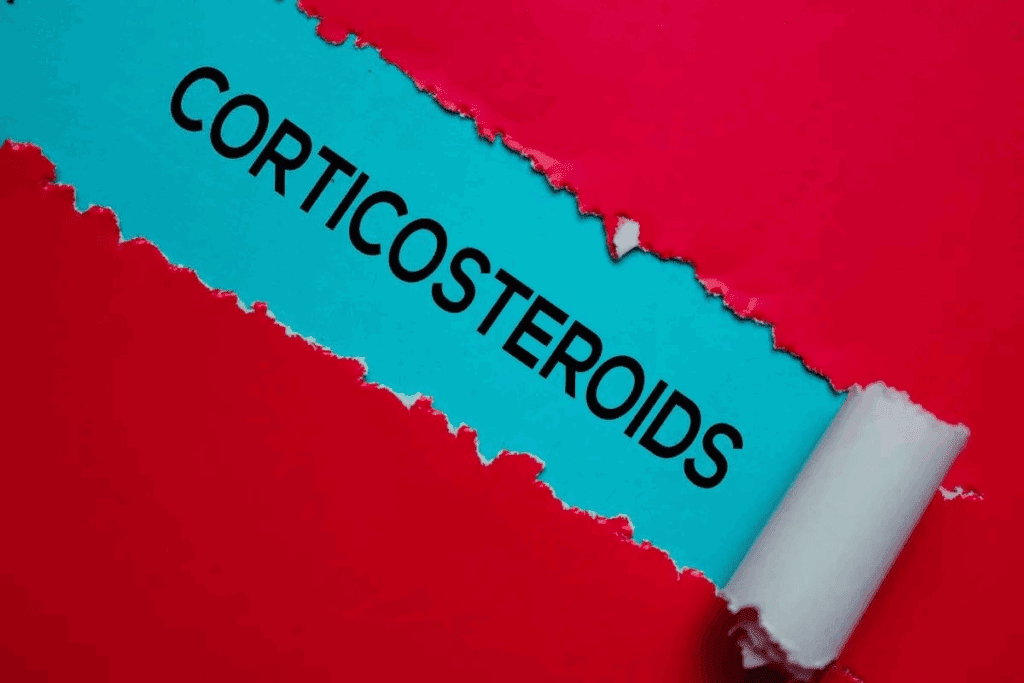Last Updated on November 26, 2025 by Bilal Hasdemir

Cortisone shots are a common treatment for joint pain and back problems. They help reduce inflammation, which in turn reduces pain. At Liv Hospital, we understand the importance of weighing the benefits and risks of steroid therapy.
Steroid injections are widely used for medical conditions like arthritis, allergies, and inflammation. While they offer quick relief, it’s essential to understand steroid injection side effects. These can include temporary pain at the injection site, changes in skin color, or, in rare cases, increased blood sugar levels.
Knowing both the benefits and side effects of steroid injections helps patients make informed decisions about their treatment.
Key Takeaways
- Common uses of steroid injections include treating arthritis and allergies.
- Potential risks and symptoms are associated with steroid therapy.
- Understanding the benefits and risks is key tosafe treatment.
- Liv Hospital provides transparent, expert care for patients considering steroid therapy.
- Reducing inflammation is a primary benefit of cortisone shots.
Understanding Corticosteroids in Medical Treatment

Corticosteroids, or steroids, are key in fighting inflammation and weakening the immune system. They are a big part of today’s medicine, helping with many inflammatory issues. We’ll look into how they work, their types, and the health problems they treat.
What Are Corticosteroids and How Do They Work?
Corticosteroids are drugs that fight inflammation like hormones from the adrenal gland. They come in injections, tablets, and capsules, each with its own use and side effects. They reduce inflammation and weaken the immune system, giving temporary pain relief and managing health issues.
Glucocorticoids vs. Mineralocorticoids: The Two Main Types
Corticosteroids are split into two main types: glucocorticoids and mineralocorticoids. Glucocorticoids mainly fight inflammation and weaken the immune system. They help with arthritis, asthma, and allergies. Mineralocorticoids, on the other hand, balance electrolytes and treat hormonal issues.
Common Medical Conditions Treated with Steroids
Corticosteroids are used for many health issues because of their strong anti-inflammatory and immunosuppressant effects. Some common uses include:
- Arthritis and other joint diseases
- Asthma and chronic obstructive pulmonary disease (COPD)
- Allergies and allergic reactions
- Autoimmune diseases such as lupus and multiple sclerosis
- Skin conditions like eczema and dermatitis
| Condition | Type of Steroid Used | Administration Method |
| Arthritis | Glucocorticoids | Intra-articular injections |
| Asthma | Glucocorticoids | Inhaled corticosteroids |
| Allergies | Glucocorticoids | Oral steroids |
Different Formulations and Administration Methods

Steroids come in many forms for targeted treatments. They can be given in different ways, based on the condition and the desired effect.
Injection Types: Intra-articular, Intramuscular, and Epidural
Steroid injections are a common method. They deliver the steroid directly to the affected area. There are several types:
- Intra-articular injections: These go directly into the joint space. They help reduce inflammation and pain in conditions like arthritis.
- Intramuscular injections: These are given into the muscle tissue. They’re used for systemic conditions or when oral steroids aren’t suitable.
- Epidural injections: These steroids are given into the space around the spinal cord. They’re often used for back pain and inflammation.
Oral Steroids: Tablets and Capsules
Oral steroids come in tablets and capsules. They’re for systemic conditions. They’re absorbed through the digestive system and spread throughout the body. Prednisone and dexamethasone are common examples.
| Oral Steroid | Common Use | Formulation |
| Prednisone | Systemic inflammation, autoimmune diseases | Tablet |
| Dexamethasone | Cerebral edema, severe allergies | Tablet, Capsule |
Other Delivery Methods: Topical, Inhaled, and Nasal
There are other ways to give steroids for targeted relief:
- Topical steroids: Creams, ointments, and lotions for skin conditions.
- Inhaled steroids: For respiratory issues like asthma, given through inhalers.
- Nasal steroids: Sprays or drops for nasal inflammation and allergies.
Each method has its own uses and benefits. Healthcare providers choose the best one for each patient’s needs.
Common Steroid Injection Side Effects: The 12 Key Symptoms
Steroid injections can help a lot, but they also have side effects. Knowing these side effects is key to managing patient expectations and avoiding problems.
Pain and Discomfort at the Injection Site
Pain or discomfort at the injection site is a common side effect. This can be mild or severe and may include swelling or bruising. Proper injection techniques and post-injection care can help mitigate this risk.
The pain usually goes away in a few days. But sometimes, it can last longer. Patients need to follow the post-injection instructions carefully to reduce discomfort.
Temporary Flare of Symptoms (“Steroid Flare”)
Some people get a temporary flare of symptoms after a steroid injection, known as a “steroid flare.” This usually doesn’t last long, but it can be uncomfortable. Monitoring and adjusting treatment plans can help manage this side effect.
A steroid flare can show up as more pain or swelling in the affected area. It’s important for patients to know this can happen and to reach out to their healthcare provider if symptoms get worse.
Skin Changes: Thinning, Discoloration, and “Steroid Flush”
Steroid injections can lead to skin changes like thinning, discoloration, and “steroid flush.” These changes can worry patients and might need extra treatment. Using the lowest effective dose can help reduce these risks.
Skin thinning, or atrophy, can happen, mainly with repeated injections. Discoloration might also occur, and sometimes it can last forever. Patients should be watched for these changes.
Facial Flushing and Hot Flashes
Facial flushing and hot flashes are common side effects of steroid injections. These symptoms are usually short-lived but can be uncomfortable. Staying hydrated and managing stress can help ease these symptoms.
Facial flushing can happen right after the injection and usually goes away by itself. Hot flashes, similar to those in menopause, can also occur due to the steroids’ hormonal effects.
Psychological and Neurological Side Effects
Steroid injections have benefits but also side effects. These can be psychological and neurological. They might be temporary, but they can really upset patients and affect their quality.
Mood Swings, Irritability, and Emotional Changes
Steroid injections can change how you feel. You might get irritable, anxious, or depressed. These mood swings can be serious and hurt your relationships.
Emotional changes can be mild or severe. They might include mood swings or even depression. Doctors should watch for these and help patients.
Sleep Disturbances and Insomnia
Insomnia and disrupted sleep are common side effects. These can make mood changes worse.
To improve sleep, keep a regular sleep schedule. Make your sleep area calm. Doctors might suggest sleep aids, too.
Headaches and Dizziness
Headaches and dizziness can happen after steroid injections. These symptoms are usually short-lived but can be annoying.
Drinking water and avoiding sudden moves can help. If these problems last, see your doctor.
| Side Effect | Symptoms | Management Strategies |
| Mood Swings | Irritability, anxiety, depression | Monitoring, support, counseling |
| Sleep Disturbances | Insomnia, disrupted sleep | Sleep hygiene practices, sleep aids |
| Headaches and Dizziness | Headaches, dizziness | Hydration, avoiding sudden movements |
Metabolic and Systemic Reactions
Steroid injections can have risks that affect health. They help with inflammation and pain, but can change metabolism a lot.
Blood Sugar Elevation and Diabetes Concerns
Steroid shots can raise blood sugar levels. This is a big worry for people with diabetes. It’s because steroids affect how the body handles sugar.
Checking blood sugar levels is key for diabetics getting steroid shots. Doctors might change how much medicine or insulin they take to keep sugar levels right.
Weight Gain and Fluid Retention
Weight gain and fluid retention are common side effects. Steroids change how the body handles water and metabolism.
The table below shows how steroid injections can affect the body:
| Metabolic Effect | Description | Management Strategy |
| Blood Sugar Elevation | Increased glucose levels | Monitor blood sugar, adjust diabetes medication |
| Weight Gain | Increase in body weight due to metabolic changes | Dietary adjustments, monitoring weight |
| Fluid Retention | Retention of fluid leading to swelling | Limit sodium intake, monitor fluid balance |
Blood Pressure Fluctuations
Steroid shots can also change blood pressure. This happens because steroids affect how the body handles fluids and blood vessels.
People with high blood pressure need to be watched closely after getting steroid shots. Changing blood pressure medicine might be needed to keep it stable.
It’s important to know about these reactions to steroid injections. By watching patients closely and making treatment plans as needed, doctors can help keep steroid injections safe.
Serious Risks of Steroid Injections
Steroid injections can offer relief, but they also carry serious risks. It’s important to understand these risks before deciding on steroid injections for treatment.
Infection and Immunosuppression
One major risk is infection. Steroid injections can weaken the immune system. This makes it harder for the body to fight off infections. People with weak immune systems are at higher risk.
The invasive nature of injections also increases infection risk. If not done properly, bacteria can get into the injection site. This can cause severe infections.
Tendon Weakening and Tissue Damage
Getting steroid injections too often can weaken tendons and cause tissue damage. This is a big concern for those who get injections in the same spot often. Tendon rupture is a serious risk.
The steroid itself and the injection process can also damage tissues. This can lead to long-term pain and reduced function in the affected area.
Adrenal Suppression and Hormonal Imbalance
Adrenal suppression is another serious risk. Steroids can lower the body’s natural corticosteroid production. This can cause hormonal imbalances and serious problems, especially if treatment stops suddenly.
High-dose and repeated injections increase the risk of adrenal suppression. Healthcare providers must watch for signs and taper doses carefully when stopping treatment.
Long-Term Consequences of Repeated Steroid Use
Using corticosteroid injections for a long time can lead to many health problems. It’s important to know these risks to choose the right treatment.
Bone Density Loss and Osteoporosis Risk
Using steroids often can cause bone density loss, which might lead to osteoporosis. Osteoporosis makes bones weak and more likely to break. This is a big concern, mainly for those with a family history of osteoporosis.
To lower this risk, we suggest checking bone density often. We also recommend taking calcium and vitamin D supplements and doing exercises that strengthen bones.
Cardiovascular Complications
Long-term steroid use can harm the heart, leading to high blood pressure and heart disease. It can also cause fluid retention and change lipid levels, making heart problems worse.
We tell patients on long-term steroids to eat well and exercise regularly. Regular doctor visits are also key to keeping the heart healthy.
Cumulative Effects on Multiple Body Systems
Long-term steroid use can affect many body systems, like muscles, hormones, and the heart. It’s important to think about these effects when considering steroid injections for a long time.
Knowing the signs of steroid withdrawal, like tiredness, joint pain, and mood swings, is important. A careful plan to stop steroids can help lessen these symptoms.
We stress the need for a detailed treatment plan. It should weigh the benefits of steroids against the risks. Regular talks with doctors are vital to adjust the plan and tackle any new problems quickly.
Common Steroid Medications and Their Specific Side Effect Profiles
It’s important to know the side effects of different steroid medications. They are used for many health issues. There are injectable and oral forms.
Injectable Steroids
Injectable steroids like methylprednisolone, triamcinolone, and betamethasone are used for their anti-inflammatory effects. Each has its own side effects based on its strength and how long it lasts.
- Methylprednisolone is often used for joint injections and has a moderate duration of action.
- Triamcinolone is known for its long-acting effects but may cause more significant local side effects.
- Betamethasone is another long-acting steroid used in various injections, including epidural injections.
Oral Steroids
Oral steroids like prednisone, dexamethasone, and prednisolone are used for many conditions. Their side effects can change based on how much is taken and for how long.
- Prednisone is a commonly prescribed oral steroid that is metabolized into its active form, prednisolone.
- Dexamethasone is a potent oral steroid used in various conditions, including severe allergies and certain cancers.
- Prednisolone is similar to prednisone but is already in its active form, making it effective for patients with certain liver conditions.
Comparing Side Effect Risks Across Different Steroid Types
When looking at side effect risks, it’s key to consider the type of steroid and how it’s given. Some steroids might have higher risks for certain side effects. But the benefits should always outweigh the risks when deciding on treatment.
We need to balance the good of steroid treatment with the possible downsides. This approach should be tailored to each patient’s unique situation. Knowing the side effects of different steroids helps doctors make better choices for their patients.
Symptoms of Coming Off Steroids: Withdrawal and Recovery
Stopping steroids needs careful planning to avoid withdrawal symptoms. Our body must adjust to not having the medication.
Physical Withdrawal Symptoms: Fatigue, Pain, and Weakness
Physical symptoms can be tough. Fatigue is a big issue, as energy drops without steroids. People also feel muscle pain and weakness, making simple tasks hard.
These symptoms happen because our body gets used to steroids. They can lower hormone levels. When steroids are gone, it takes time for our body to start making hormones again.
Psychological Withdrawal Effects: Mood Changes and Depression
Psychological effects are just as tough as physical ones. Mood swings are common, with feelings of irritability, anxiety, or depression. These feelings come from the hormonal imbalance when steroids are stopped.
It’s important to know these mood changes are part of the withdrawal. They might need help from healthcare professionals to manage.
Tapering Strategies to Minimize Withdrawal Effects
Slowing down steroid use is key to lessening withdrawal symptoms. By slowly cutting down the dosage, the body can adjust better. This makes withdrawal effects less severe.
- Gradually reduce the steroid dosage over a period of time.
- Monitor the patient’s condition closely for any signs of withdrawal.
- Adjust the tapering schedule as needed based on the patient’s response.
Using these tapering strategies, doctors can help patients deal with steroid withdrawal. This makes recovery easier and more manageable.
Conclusion: Minimizing Risks While Maximizing Benefits of Steroid Treatment
Steroid injections can help with many medical issues, but we must think about the good and bad sides. Knowing the possible side effects helps both patients and doctors avoid problems.
Choosing the right type and how to use steroid injections is key. Also, how to slowly stop using them is important for the best results. Used wisely, these injections can greatly improve life quality.
We aim to give top-notch healthcare with full support and advice. By focusing on the benefits and reducing risks, we can get the best results from steroid treatment together.
FAQ
What are corticosteroids, and how do they work?
Corticosteroids, or steroids, are medicines that fight inflammation and weaken the immune system. They help treat many health issues, like arthritis, allergies, and autoimmune diseases.
What are the different types of corticosteroids?
There are two main types: glucocorticoids and mineralocorticoids. Glucocorticoids treat inflammation and immune disorders.
How are steroids administered?
Steroids can be given in several ways. This includes injections, oral pills, topical creams, inhalers, and nasal sprays.
What are the common side effects of steroid injections?
Steroid injections can cause pain, temporary symptom worsening, skin issues, and mood changes. They can also lead to facial flushing and hot flashes.
Can steroid injections cause psychological and neurological side effects?
Yes, they can. Mood swings, irritability, emotional changes, sleep issues, headaches, and dizziness are possible.
What are the metabolic and systemic reactions to steroid injections?
Steroid injections can raise blood sugar, cause weight gain, fluid retention, and blood pressure changes.
What are the serious risks associated with steroid injections?
Serious risks include infections, a weakened immune system, tendon damage, and hormonal imbalances. They can also cause adrenal gland suppression.
What are the long-term consequences of repeated steroid use?
Long-term use can lead to bone loss, osteoporosis, heart problems, and harm to multiple body systems.
How do different steroid medications compare in terms of side effects?
Each steroid has its own side effects. Injectable steroids like methylprednisolone and triamcinolone, and oral steroids like prednisone and dexamethasone, have different risks and benefits.
What happens when you stop taking steroids?
Stopping steroids can cause withdrawal symptoms. These include physical symptoms like fatigue, pain, and weakness. Psychological symptoms like mood changes and depression can also occur. Tapering can help lessen these effects.
What are the symptoms of coming off steroids?
Symptoms include physical withdrawal symptoms like fatigue, pain, and weakness. Psychological effects like mood changes and depression can also happen.
How can withdrawal effects be minimized when stopping steroid treatment?
Using tapering strategies is key to reducing withdrawal effects when stopping steroids. This helps ensure a smoother recovery.
Reference:
Cole, J. L. (2020). Steroid-induced sleep disturbance and delirium: A focused review for critically ill patients. PMC, 7357890. Retrieved from https://www.ncbi.nlm.nih.gov/pmc/articles/PMC7357890






